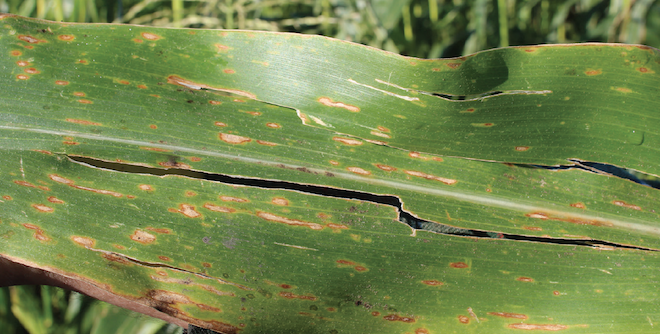

Jan 24, 2020Midwest growers fight bacterial leaf streak
Tar spot captures the most attention as a new foliar disease in corn in the Midwest, but bacterial leaf streak may be as big of a concern to sweet corn growers. Bacterial leaf streak can infect plants early, has alternate hosts, can’t be controlled with fungicides – and sweet corn is more susceptible.
“In Minnesota, it’s a bigger problem in sweet corn than in field corn,” said Dean Malvick, professor in the University of Minnesota’s Department of Plant Pathology. “We have seen high levels of damage in sweet corn.” Minnesota grows more than 100,000 acres of sweet corn with two-thirds of it going to processing.
Bacterial leaf streak was first positively identified in the U.S. in Nebraska in 2016 and the worst damage there has been in popcorn. The disease became progressively worse in 2017 and 2018 and spread into Oklahoma, Texas, Kansas, Colorado, Iowa, Illinois, South Dakota and Minnesota.
But 2019 was a little different. “We didn’t see much this year in Minnesota,” Malvick said. “It seems that the weather patterns that favor it weren’t here this year.”
Part of the problem in some states is bacterial leaf streak is easily misidentified as gray leaf spot.
Both diseases appear as yellow, tan or brown lesions on the leaves. The lesions can be small flecks or up to several inches long. However, the lesion margins of bacterial leaf speck are jagged or wavy while the margins of gray leaf spot lesions are usually smooth.
Lab tests are the only way to positively identify the foliar symptoms as bacterial leaf streak. The disease isn’t controlled by the fungicides sprayed for gray leaf spot.
Bacterial leaf streak can infect sweet corn as early as the V4 stage. With an early start, there’s greater potential for damage.
Bacterial leaf streak has several alternate hosts. The list includes green foxtail, shattercane, yellow nutsedge, certain varieties of orchardgrass, oats, and timothy, certain varieties of warm-season, native grasses and a few others. This makes good weed control in rotation crops essential.
Bacterial leaf streak of corn has been reported in South Africa and more recently in Argentina. The source of the outbreaks in Nebraska and across the Midwest is unknown. “We don’t know where it came from or how it got here,” Malvick said.
The disease survives on infested crop residue. Rotation is a control, but resistant varieties may eventually be the long-term solution.
There are varietal differences in susceptibility to bacterial leaf streak and multiple sweet corn varieties are being evaluated at the University of Minnesota’s Southern Research and Outreach Center at Waseca.
All of the varieties tested in 2019 were inoculated with the disease at the V4 stage. This produced disease levels high enough to cause significant yield losses in some varieties.
“We’re trying to determine how to inoculate plants the most effectively in the field,” Malvick said. “We inoculated at V4. Sweet corn is clearly susceptible at that stage.” The research is also trying to assess bacterial leaf streak’s effect on yield and quality.
However, the disease has a high degree of variability. Sweet corn varieties inoculated with the disease at the University of Minnesota’s Rosemount Research and Outreach Center showed no infection. Rosemount is about 60 miles from Waseca. With such variability, the exact conditions that favor the disease are hard to determine.
“There are a lot of questions,” Malvick said. “There’s a lot we don’t know yet about bacterial leaf streak of corn.”
— Dean Peterson, VGN correspondent














